Prairie Skies 2007
Disclaimer: The opinions expressed here are mine alone, and I
don't
speak for the organizers of Prairie Skies.
I always look forward to the one day a year that I drive up I-57 to
Manteno
and head over to Camp Shaw-Was-Nas-See, site of Astrofest for many
years,
and now the site of the Prairie Skies Star Party starting in 2004.
I
wonder if this year was Lastrofest? We shall see. Some
might
think that I dislike Astrofest, but that is not the case at all - I had
a
great time at several Astrofests at Camp Shaw, but I had had quite
enough
of the new site at Vana's after two disappointing years. This
year
it was reduced to a two-night event, and I am told that they didn't
have
showers available. If they can find a new site for Astrofest with
decent
accommodations, they might have a chance at reviving it.
So where are people going? Astrofest used to draw over 800
people.
A tremendous number of new, smaller star parties have sprung
up
in the last few years in the Illinois-Indiana region, so the
"competition"
is growing, and so are these smaller events. This year the
Illinois
Dark Skies Star Party was the same weekend as Prairie Skies. I
attended
IDSSP last year and had a great time (except for the pesky severe
thunderstorm
that rolled through on Friday), but this year I had already committed
to
Prairie Skies early in the year, before IDSSP was scheduled. To
be
quite fair, PS announced their dates well in advance of anyone else,
and
it would have been nice if IDSSP had been able to schedule for another
weekend,
but often these choices are limited by other factors, such as getting
things
scheduled with the state park it is held at. IDSSP has great dark
skies,
much better than PS, so it would be nice to be able to attend both
again
next year. I really am quite torn between these two events, since
I
love dark skies. Prairie Skies has already announce their date
for
next year - September 25-28, 2008. So, if this scheduling
conflict
happens again next year, there is just no excuse except IDSSP wants to
directly
compete with PS. It appears that PS and IDSSP drew just under 200
people
each, so this is still half of the attendance of the old Astrofest at
its
peak. Anyway, moving on.....
Prairie Skies was started by those who wanted to continue to have a
star
party at Camp Shaw, due to nostalgia, scenery, amenities, and various
other
reasons. The place is quite special to me, having been there
quite
a few times, so I told the organizers I would do what I could to help
promote
it. This includes doing talks, and in the last two years, doing
mirror
testing "live" in the dining hall and leading a telescope walkabout
during
which we make a circuit around the field seeking out new and creative
telescopes
and accessories. The skies are not very dark, but the Milky Way
is
quite visible overhead, and the trees shield the field from most other
local
lights. The uh... person.. across the street refused to shield or
turn
off his light, so the organizers hang up a long wall of black plastic
along
one side of the field to block it.
I arrived on a beautifully clear Thursday afternoon and set up my 12.5"
Cassegrain
on its stand and equatorial platform. After I ate my dinner, Mike
Conron
arrived with the 30" F/3.8 in the trailer towed behind his new minivan
and
we set up the scope and our camp. He had been delayed by evening
traffic
in Kankakee, one of the main thoroughfares of which turns into a
rolling
traffic jam after 5pm. The sun set (below) and were treated to a
beautiful
night, though the seeing was absolutely awful. Stars were
throbbing
blobs the whole night. I turned in around 3am.

Friday dawned warmer and still sunny, and I had mirror testing
scheduled
for 10am. After breakfast we took the tester and test stand over
to
the dining hall and tested one 10" F/4.5 mirror. It proved to be
quite
good, though the surface was a little rough. It represented a
very
good buy on a used commercial mirror, though.
More people arrived on Friday, though the field was far from full.
Friends
arrived from Cincinnati, and they set up camp across the "road" from
our
area (shown in the photo below). After eating pizza in town we
settled
in for a night of observing. In the photo below, from left to
right
we have Ed Jones, Sue Rismiller, Mike Conron, John Pratte (from
Illinois,
but formerly of Cincinnati) and Dick Wessling assembling his 16" F/4.
You
can always tell his scopes by their yellow and black color scheme and
painted
on sun and stars.
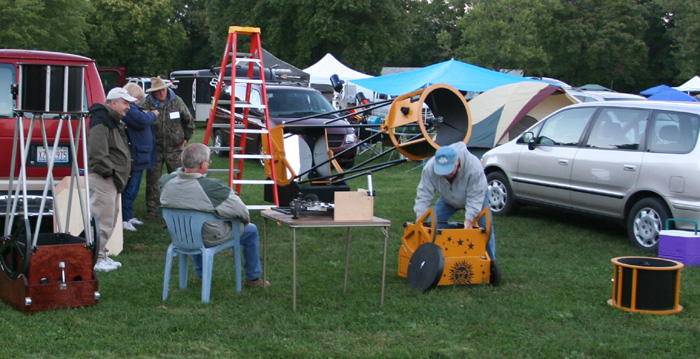
Right after this was taken, I walked across the road in front of the
camp
and got some colorful photos of the sunset over the partially harvested
cornfield.

Darkness fell, and Friday night was good. It was slightly less
transparent
than Saturday, but the seeing was much, much better. After it
cooled
off, glimpses of the central star in the ring could be had in my 12.5"
Cassegrain
at around 450X, and several others confirmed that they could see it.
At the request of some friends, I went around to their telescopes with
a
Ronchi grating and taught them a bit of testing. We checked a
number
of telescopes with different focal ratios, and I carefully made the
following
point to those who followed me around on this little tour. The
Ronchi
test using a star as a source is essentially a test of transverse error
of
the light rays. Since longer focal ratio telescopes create
physically
larger airy disks at the focus and the grating is the same frequency
for
all of the telescopes tested that night (133 LPI) , the sensitivity
of
the Ronchi test increases with focal ratio. So, a small bend
in
the lines as seen through my F/12.5 Cassegrain is equivalent to an
almost
imperceptible bend seen in an F/4.5 instrument.
It was on this night of better seeing that we confirmed that we indeed
still
have a serious problem with astigmatism in our 30" F/3.8. A new
secondary
holder was made to replace a piece of aluminum that the secondary had
formerly
been glued to, and it was installed just before this star party.
This
reduced the weight of the secondary cage, improving the balance of the
scope,
and it improved the performance of the secondary thermally and allowed
us
to easily install a heater in the future. It also seemed to
remove
any warping issues that the secondary had when it was glued to the
piece
of metal that changed temperature a lot through the night.
However,
significant astigmatism remained, and it was not aligned with the
optical
axis. Given that the 30" was initially ground and polished on a
machine
that was not quite up to the task and that had a warped wooden
turntable,
this is not surprising. So, since I now have a machine that can
handle
a mirror of this size, when the coating goes to hell in the future,
I'll
simply refigure it. I've made many mirrors in that size range
since
then with no signs of astigmatism.
Friday night continued steady, and after making the testing rounds I
ended
up back at my Cassegrain, checking out the Trapezium low in the eastern
sky,
and managing to glimpse a little detail on Mars, which was also low in
the
east. I turned in a round 3:30am and slept quite well as it had
cooled
off quite a bit.
On Saturday I helped judge the ATM contests in the morning. I was
hoping
for a few more entries, but we found some beautiful work, particularly
in
the case of Ed Jones' 8" F/7 "CHiefspiegler". The CH stands for
Catadioptric
Herschelian. The primary is tilted a few degrees, and a secondary
mirror
directs light through two lenses at an angle that correct the
astigmatism
created by the primary tilt. I wish I'd gotten a chance to look
through
this scope, but I missed it on Friday night, and I had to leave before
it
got dark on Saturday night. Ed is shown below with the scope and
his
beautiful wooden equatorial platform, also built by him. The
second
photo shows him describing the telescope on the walkabout on Saturday
afternoon.

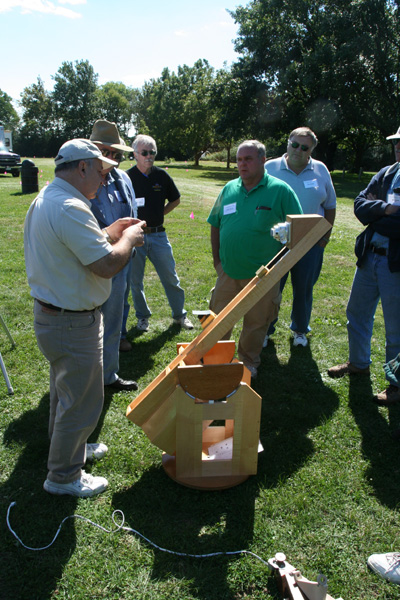
John Pratte did not enter the contests, but showed one of the 16" F/4s
he
has been building this year. It featured beautiful woodwork, and
a
very solid, expertly machined mirror cell. The mirror cell is
shown
in the second and third photos below. In the second John is
describing
it to Aart Olsen.
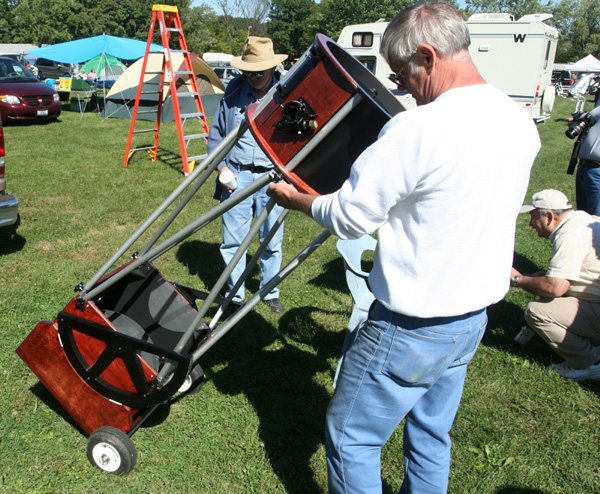
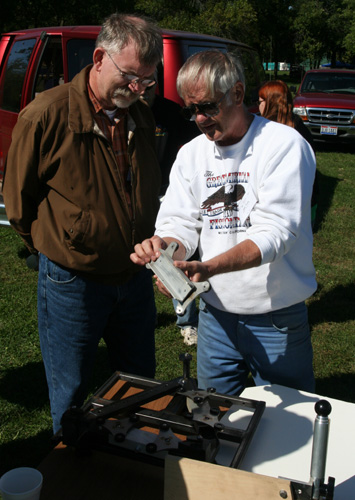
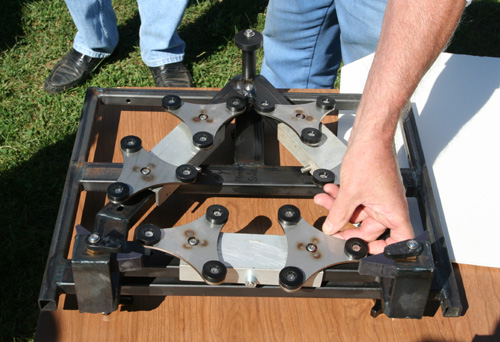
Other scopes of note were Steve Sands' 20" F/4, also not entered this
year.
In the background is a refractor that was being restored.
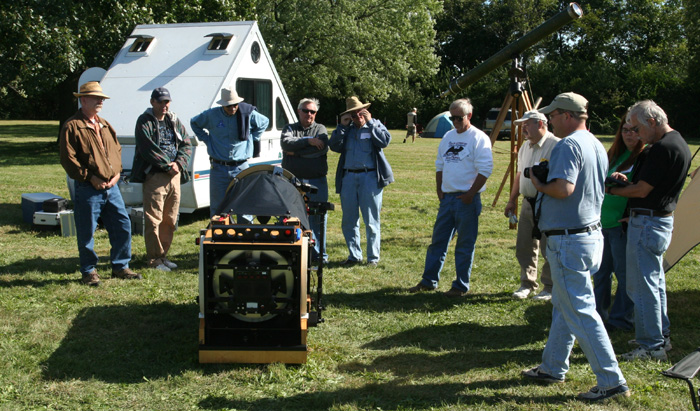
After the walkabout wrapped up, I took some photos. Below is an
image
of someone who didn't want either their bike or their scope to be
stolen.
Personally, if I had a choice I'd steal the bike! :)

Here's a panorama of the telescope field, with north at left and south
at
right. Following that is a view of the field from the east,
looking
west.


The field filled up quite well on Saturday, with a few cars at the
extreme
south edge of the field, seen past the cabin in the left side of the
image
above. Attendance was up this year, but for some strange reason
ABSOLUTELY
NO VENDORS SHOWED UP. What the hell?!? I was looking
forward
to checking out observing chairs and eyepieces. The organizers
said
they did the same thing as in previous years, but no one came. Oh
well.
With the multiplication of star parties in the reason, I am
afraid
that the vendors are being spread too thin. So, if any vendors
are
reading this, once again the dates for Prairie Skies have already been
set
for next year - September 25-28, 2008. Please make a note
and
please show up!!!
Well Saturday evening came, and the sun set. It was time for me
to
leave. I drove home to Champaign, unloaded, and managed to fall
asleep
by about 10pm, the earliest I had gone to sleep (without being sick)
for
a very, very long time. After two long nights of observing I
slept
until 5am and got up and drove to Cincinnati to do something I hadn't
done
for years - ride some serious roller coasters! The elevation
changes
were quite a bit more severe than climbing up and down the ladder to
use
the 30", and I had a great time on a beautiful sunny day at Kings
Island.
Turns out the clouds had rolled in a few hours after I left on
Saturday
night, so I made the right choice. On Sunday night I actually got
to
watch fireworks and see Cygnus while being winched up the first hill on
the
last coaster ride of the night, so I did get a little observing in.
:)











